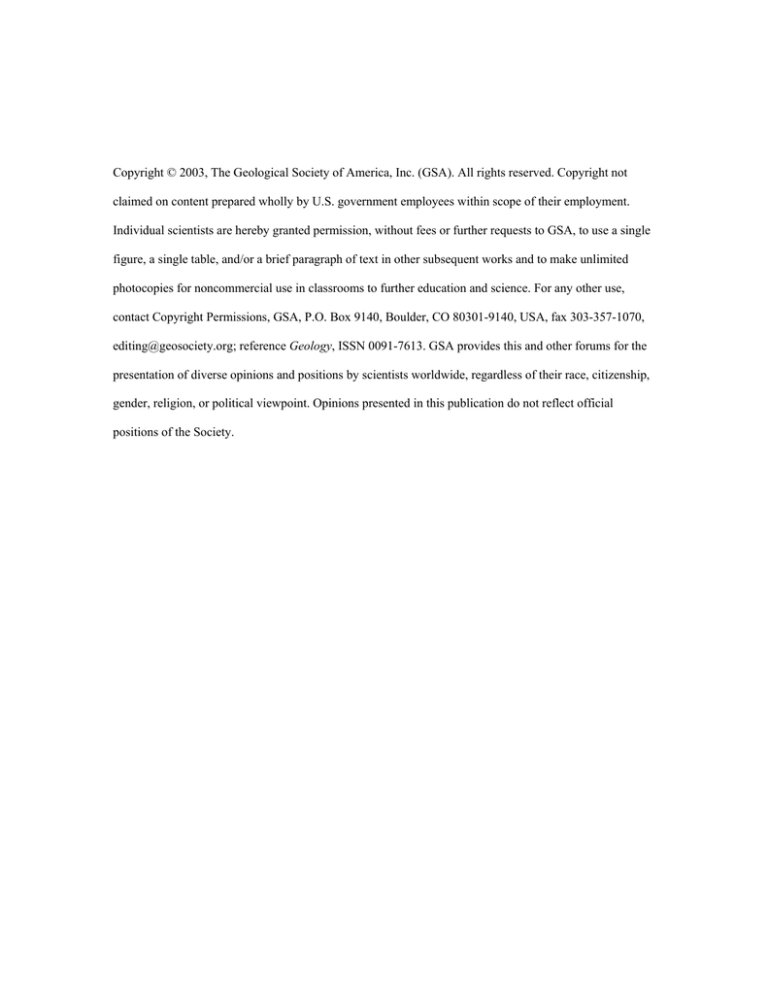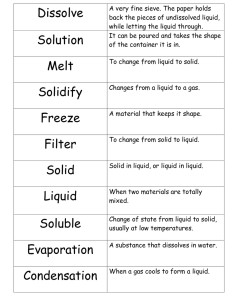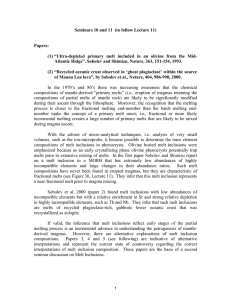
Copyright © 2003, The Geological Society of America, Inc. (GSA). All rights reserved. Copyright not
claimed on content prepared wholly by U.S. government employees within scope of their employment.
Individual scientists are hereby granted permission, without fees or further requests to GSA, to use a single
figure, a single table, and/or a brief paragraph of text in other subsequent works and to make unlimited
photocopies for noncommercial use in classrooms to further education and science. For any other use,
contact Copyright Permissions, GSA, P.O. Box 9140, Boulder, CO 80301-9140, USA, fax 303-357-1070,
editing@geosociety.org; reference Geology, ISSN 0091-7613. GSA provides this and other forums for the
presentation of diverse opinions and positions by scientists worldwide, regardless of their race, citizenship,
gender, religion, or political viewpoint. Opinions presented in this publication do not reflect official
positions of the Society.
Primary melt inclusions in andalusite from anatectic graphitic
metapelites: Implications for the position of the Al2SiO5 triple point
B. Cesare*
Dipartimento di Mineralogia e Petrologia, Università di Padova, Consiglio Nazionale delle Ricerche, Istituto di
Geoscienze e Georisorse, Corso Garibaldi, 37, 35137 Padova, Italy
C. Marchesi Dipartimento di Mineralogia e Petrologia, Università di Padova, Corso Garibaldi, 37, 35137 Padova, Italy, and
Departamento de Mineralogı́a y Petrologı́a, Facultad de Ciencias, Universidad de Granada, Fuentenueva s/n,
18002 Granada, Spain
J. Hermann Research School of Earth Sciences, Australian National University, Canberra ACT 0200, Australia
M.T. Gómez-Pugnaire Departamento de Mineralogı́a y Petrologı́a, Facultad de Ciencias, Universidad de Granada,
Fuentenueva s/n, 18002 Granada, Spain
ABSTRACT
Anatectic crustal xenoliths in the Miocene volcanic rocks of
Mazarrón (southeast Spain) contain andalusite with melt inclusions, an unprecedented finding. Microstructures indicate that the
melt inclusions were trapped during andalusite growth. The volatile content of the peraluminous inclusions is too low (Cl , 0.4
wt%, F , 0.3 wt%, P ø 1500 ppm, B , 850 ppm) to have caused
a significant reduction of the wet solidus temperature. Moreover,
the presence of graphite, as observed, during partial melting is
expected to have raised the temperature of the wet solidus. Melting
temperatures for the inclusions—obtained from quartz-albite-orthoclase haplogranite system (680–790 8C), Zr (620–705 8C), and
light rare earth element (615–725 8C) thermometry—indicate that
the stability of andalusite 1 melt is incompatible with the position
of the most commonly used andalusite 5 sillimanite equilibrium,
and that the Al2SiO5 triple point must be placed at higher temperatures and pressures.
Keywords: andalusite, crustal melting, low-pressure metamorphism,
melt inclusions, sillimanite, thermobarometry.
INTRODUCTION
The Al2SiO5 polymorphs constitute the backbone for the construction of phase relationships and thermobarometric methods in metapelitic rocks. Despite the general adoption of the triple point of Holdaway
(1971), the pressure-temperature (P-T) location of the andalusite (And)
5 sillimanite (Sil) curve is still controversial, because it is extremely
difficult to constrain experimentally. Triple points at higher P and T
(e.g., Pattison, 1992) show better agreement with natural assemblages
from low-P metapelites and are now increasingly used (Johnson et al.,
2003, and references therein). In addition, a reaction of And 5 Sil at
higher T would account for a stable P-T field for And 1 melt. The
stability of And 1 melt does not by itself invalidate the Holdaway
(1971) triple point. In fact, if andalusite stability is expanded by minor
elements (e.g., Fe31) and/or if the haplogranite solidus is lowered by
significant solution of Al2O3 and/or volatiles (e.g., B, F), a P-T field
for And 1 melt can also be obtained with the And 5 Sil curve of
Holdaway. Kerrick (1990) urged more attention to natural laboratories
as the way to constrain the location of the And 5 Sil curve, but until
now a definitive solution to this controversy has been hampered by the
lack of precise data on the chemistry of And-bearing natural melts.
Here we characterize silicate melt inclusions in andalusite from
crustal xenoliths in the Neogene volcanic province of southeast Spain.
This is an exceptional finding, because melt inclusions in andalusite
have never been reported until now. A detailed analysis of glass composition and volatile contents was used to evaluate the temperature of
melt in the inclusions and to constrain the P-T locations of the And 5
*E-mail: bernardo.cesare@unipd.it.
Sil curve and melt solidus. The results support a higher P-T triple point
such as that of Pattison (1992) and highlight the role of graphite in
low-P fluid-present melting.
GEOLOGIC SETTING AND PETROGRAPHY
The xenoliths in the Miocene high-K calc-alkaline volcanic rocks
of the Neogene volcanic province (Fig. 1) represent restites after anatexis of crustal protoliths, which took place at 9.1 Ma in the context
of lithospheric thinning that accompanied the opening of the Alborán
Sea (Cesare and Gómez-Pugnaire, 2001).
Andalusite-bearing xenoliths occur in the Neogene volcanic province along a belt extending for ;100 km (Fig. 1) and are particularly
abundant in the area of Mazarrón. Andalusite is observed in xenoliths
that also contain sillimanite, hercynite (XFe 5 0.80), cordierite (XFe 5
0.50–0.60), biotite (XFe 5 0.70, TiO2 to 6.0 wt%), plagioclase (An40–50),
glass, and graphite. K-feldspar and quartz are present only as inclusions
in other minerals. Glass occurs as interstitial films and as silicate melt
inclusions in all minerals. Graphite is a ubiquitous phase of these xenoliths. Resorbed grain boundaries and variable replacement by sillimanite indicate that andalusite is a metastable relict and that the xenoliths finally equilibrated within the sillimanite stability field (Cesare
et al., 2002). However, the initial stages of the partial melting history
are preserved in andalusite, in the form of mineral, fluid, and melt
inclusions.
Mineral inclusions in andalusite are quartz, plagioclase (An20–40),
K-feldspar, biotite, graphite, and hercynite. The increase of anorthite
content from inclusions to matrix plagioclase is consistent with the
progress of anatexis under increasing temperature. Fluid inclusions in
Figure 1. A: Geographic location of Neogene volcanic province of
southeast Spain; black box indicates area enlarged in B. B: Main
edifices of Miocene volcanic rocks.
q 2003 Geological Society of America. For permission to copy, contact Copyright Permissions, GSA, or editing@geosociety.org.
Geology; July 2003; v. 31; no. 7; p. 573–576; 5 figures; 1 table; Data Repository item 2003082.
573
Figure 2. Main microstructural aspects of melt inclusions in andalusite from xenoliths of Mazarrón. A: General view of inclusion-rich
andalusite (And) with resorbed grain boundaries, surrounded by cordierite (Crd) and interstitial devitrified glass (M). Inclusions consist of
melt (arrows), biotite (B), hercynitic spinel (S), and graphite (G). B: Subspherical to tubular (arrows) melt inclusions. Walls of tubular
inclusions are parallel to andalusite cleavage (top right to bottom left). C: Two adjacent melt inclusions; one is fresh, with clear glass and
small shrinkage bubble, and other is devitrified (arrow). Fib is fibrolite. D: One melt inclusion with two shrinkage bubbles. Double meniscus
in left-side bubble (arrow) attests to presence of fluid in it, determined as H2O. Scale bars represent 100, 60, 150, and 50 mm, respectively.
andalusite consist of CO2 1 CH4 mixtures rich in CO2. Melt inclusions
are common; they range from subspherical (approximate diameters
, 40 mm) to irregular or tubular in shape (lengths to 150 mm). Subspherical inclusions are randomly distributed in the andalusite host and
may form clusters associated with graphite, hercynite, or other solids
(Fig. 2A). Tubular inclusions are often parallel to the crystallographic
axes of andalusite (Fig. 2B). Microstructural evidence (further detailed
in Fig. DR11) points to a primary trapping origin (i.e., during andalusite growth) for most melt inclusions.
The glass in the inclusions is in most cases clear and fresh (Fig.
1GSA Data Repository item 2003082, Figure DR1, microstructural relationships between melt inclusions and host andalusite, and Appendix DR1, analytical methods, is available on request from Documents Secretary, GSA, P.O.
Box 9140, Boulder, CO 80301-9140, USA, editing@geosociety.org, or at
www.geosociety.org/pubs/ft2003.htm.
TABLE 1. REPRESENTATIVE ANALYSES OF MELT INCLUSIONS AND THEIR
ANDALUSITE HOSTS IN XENOLITHS OF MAZARRÓN
MA 2-2
Oxide
SiO2
Al2O3
FeO*
MnO
MgO
CaO
Na2O
K2O
Cr2O3
Cl
Total
Element
Li
Be
B
P
Ti
V
Zr
Sum LREEs
MA 5-10
Melt
Melt
And
Melt
Melt
And
(wt%)
(wt%)
(wt%)
(wt%)
(wt%)
(wt%)
68.41
15.07
1.61
0.03
0.09
1.05
2.65
5.37
0.00
0.37
94.65
68.98
15.16
1.34
0.00
0.11
0.79
3.55
5.72
0.01
0.33
96.01
36.57
63.32
0.15
0.00
0.03
0.00
0.00
0.00
0.01
0.00
100.08
71.21
13.87
1.46
0.15
0.12
0.61
2.72
5.74
0.00
0.27
96.15
70.35
14.19
1.69
0.04
0.10
0.63
2.64
6.31
0.00
0.36
96.31
36.59
63.34
0.23
0.04
0.02
0.01
0.01
0.01
0.02
0.00
100.27
(ppm)
(ppm)
(ppm)
(ppm)
(ppm)
(ppm)
118
0.3
1430
2227
603
39
29
31
bdl
0.2
972
1402
659
5.1
47
33
0.8
0.1
9.6
133
210
78
bdl
bdl
22
2.3
934
1063
551
0.6
26
32
224
0.6
1434
2117
443
4.4
42
20
bdl
bdl
4.9
121
74
57
bdl
bdl
Note: Oxide components determined by electron microprobe; elements by laserablation inductively coupled plasma–mass spectrometry; bdl 5 below detection limit;
And 5 andalusite; LREEs 5 light rare earth elements.
*Total iron as FeO.
574
2C). Inclusions may contain a small shrinkage bubble. Some shrinkage
bubbles display a double meniscus (Fig. 2D); in these bubbles, a lowdensity aqueous solution was detected.
ANDALUSITE AND MELT COMPOSITIONS
Table 1 reports representative analyses of andalusite and melt inclusions from two xenoliths. Details of electron microprobe (EMP) and
laser-ablation inductively coupled plasma–mass spectrometry (LAICP-MS) techniques can be found in Appendix DR1 (see footnote 1).
Andalusite is virtually stoichiometric Al2SiO5, with Fe2O3 , 0.4 wt%
(average 0.2) and MgO and MnO , 0.04 wt%. The only measured
trace elements present in significant quantities are P (80–200 ppm), Ti
(60–230 ppm), and V (;45–83 ppm). B in andalusite ranges from 3.5
to 11 ppm.
Melts in inclusions are peraluminous (alumina saturation index 5
1.2), felsic (FeO 1 MgO 1 TiO2 , 1.6 wt%) rhyolites, with CaO ,
1 wt%, and molar K2O . Na2O. On a CIPW-normative basis, the melts
are corundum normative (;3%) and cluster around an average composition of Q27Ab25Or33An4. In the CIPW-normative Q-Ab-Or (quartzalbite-orthoclase) diagram for haplogranites (Fig. 3), melts plot below
the cotectic curve on the Or-rich feldspar side of the thermal minima.
Cl contents analyzed by EMP are ,0.4 wt%. F was analyzed in only
some melt inclusions, and its average content is ,0.3 wt%. P analyzed
by LA-ICP-MS is on average 1500 ppm (0.35 wt% P2O5), but occurs
in maximum concentrations of 3800 ppm. B is highly variable; it av-
Figure 3. CIPW-normative Q-Ab-Or (quartz-albite-orthoclase) diagram reporting average compositions (crosses) and 1s contours
(shaded fields) of melt inclusions in andalusite from two studied
samples. Also reported are thermal minima or eutectics (dots) and
cotectic curves at variable pressure and Al2O3 saturation.
GEOLOGY, July 2003
erages ,850 ppm, which corresponds to ,0.27 wt% B2O3. Only 2 of
33 inclusions have B contents of ;3000 ppm (;1 wt% B2O3). Zr is
between 10 and 50 ppm, whereas the sum of the light rare earth elements (LREEs) varies from 10 to 70 ppm. The variation in trace elements is far above the analytical uncertainties. Therefore, it appears
that andalusite trapped melts with different compositions.
With the adopted EMP setup, the H2O contents of the melts can
be estimated (Devine et al., 1995) as the difference from 100% of the
EMP totals (92.5–99.5 wt%) plus the other elements detected by LAICP-MS (;1 wt%). Therefore, the H2O contents are 0–6.5 wt% (average 4.0 wt%). Because there is evidence that H2O exsolution occurred in some inclusions (Fig. 2D), it is likely that the primary H2O
content was toward the higher side of the range (4.0–6.5 wt%).
DISCUSSION
Andalusite 1 Melt Equilibrium
The primary origin of melt inclusions is cogent evidence that andalusite was growing in the presence of a leucogranitic melt. Based on
the rock type where andalusite is found, on the inferred P-T path of
the xenoliths, and on the occurrence of quartz and K-feldspar only as
anhedral inclusions in andalusite, we infer that andalusite did not crystallize from the melt, but with it, as a result of a peritectic melting
reaction of the type quartz 1 K-feldspar 1 plagioclase 1 fluid 1 A
5 melt 1 andalusite 1 B, where fluid denotes a graphite-saturated
C-O-H fluid, and A and B are additional reactants and products. The
microstructural evidence of growth of andalusite in the presence of
melt is a key observation supporting the equilibrium of And 1 melt.
Although metastable growth of andalusite in the sillimanite stability
field cannot be ruled out a priori, we consider this possibility untenable
in the light of the high-temperature, melt-present conditions that favor
reaction kinetics and the systematic distribution of the And 1 melt
assemblage on a regional scale (.102 km).
Melt Temperatures
The compositions of melt inclusions provide thermobarometric
constraints for the And 1 melt assemblage. The location of the melts
in the Q-Ab-Or triangle (Fig. 3) indicates that their temperatures were
higher than the eutectic minimum in the Al2O3-saturated haplogranite
system (;660 8C at 2 kbar, Holtz et al., 1992). Extrapolation of the
Al2O3-saturated phase relationships at reduced aH2O values compatible
with the presence of graphite (see next section) would indicate melt
temperatures, bracketed between liquidus and solidus, in the range
680–790 8C (average 735 8C). Zircon and monazite were present in
the xenoliths during the entire partial melting process, so the variation
of Zr (Watson and Harrison, 1983) and LREEs (Montel, 1993) can be
expressed as a function of melt temperature. The two methods agree
very well (Fig. 4). Sample MA 5-10 has generally lower temperatures,
in the range 620–705 8C for Zr and 615–685 8C for LREEs. Sample
MA 2-2 yields values of 670–695 8C for Zr and 675–725 8C for
LREEs. The range of T determined with all methods strongly supports
a prograde growth of andalusite in the presence of melt.
Location of And 5 Sil and the Wet Solidus
The position of the And 5 Sil phase boundary can shift in P-T
space because of partitioning of minor elements between the two polymorphs. At Mazarrón, only Fe2O3 has the potential to enlarge the andalusite stability field, but its content (0.2 wt%) results in a shift of
the equilibrium of ,5 8C at 2 kbar (Kerrick and Speer, 1988). Therefore, andalusite was not stabilized to higher T by minor elements.
Because the melts in the inclusions coexist with andalusite, the
Al2O3-saturated solidus must be considered. This is situated at ;30 8C
lower T (at 2 kbar) than the haplogranite solidus (Holtz et al., 1992).
Additional temperature-lowering effects of B (B2O3 , 0.3 wt%) and
F (,0.3 wt%) are estimated to be ,15 8C each (Pichavant and ManGEOLOGY, July 2003
Figure 4. Trace element composition of melt inclusions in andalusite from sample MA 5-10 (squares) and MA 2-2 (diamonds).
Light rare earth element (S LREE) label refers to sum from La
to Gd, excluding Eu. Selected symbols are labeled with calculated temperatures obtained from LREEs and Zr (given in italics)
thermometry.
ning, 1984). By contrast, CaO, FeO, and MgO in the melt result in a
raising of the solidus temperature: CaO leads to an increase of ;10
8C (Johannes, 1984), whereas the effect of FeO 1 MgO is ;10–20 8C
(Icenhower and London, 1995).
A drastic shift in solidus temperature is caused by graphite, which
displaces fluid-present melting equilibria to higher T, owing to the lowering of aH2O in the fluid. This effect can be quantified by intersecting
the isopleths of the maximum H2O content of graphite-saturated fluids
(X m
H2O, Connolly and Cesare, 1993) and those of XH2O values of fluids
coexisting with haplogranitic melts (e.g., Ebadi and Johannes, 1991).
The displacement (Fig. 5) is negligible for P . 7 kbar and increases
with decreasing P (e.g., 35 8C at 2 kbar). Unlike in the cases of Al2O3,
B, and F, such displacement is a minimum, because it is calculated for
maximum XH2O values.
Implications for the Al2SiO5 Triple Point
Figure 5 depicts the P-T relationships between the herein-constrained graphitic, peraluminous, haplogranitic solidus and the And 5
Sil equilibria of Holdaway (1971) and Pattison (1992), along with the
thermometric estimates provided by the melt inclusions. It is apparent
that only with the And 5 Sil of Pattison (1992) is a field for And 1
melt 1 graphite possible. Additionally, the melts in the inclusions were
generated over a temperature range of ;50–100 8C, indicating that a
significant And 1 melt field must exist. The temperature range of 670–
725 8C determined in sample MA 2-2 is remarkably consistent with
the And 1 melt field that results from the herein-constrained solidus
and the triple point of Pattison (1992). Temperatures from sample MA
5-10 are slightly lower (615–705 8C), but can be fully explained only
using the triple point of Pattison (1992). The best fit for the And 1
melt field is obtained at P 5 2.0–2.5 kbar; such a pressure is in good
agreement with the estimated 4.0–6.5 wt% H2O of the melts (Fig. 5)
if compared with values reported by Johannes and Holtz (1996).
The confirmation of the Al2SiO5 triple point at higher P-T than
generally assumed has far-reaching consequences for the understanding
of low-P–high-T metamorphism and crustal melting. The And 5 Sil
575
discriminating between different triple points. Our data show that in
low-P partial melting of metapelites, the coexistence of And 1 melt
should be the rule rather than the exception. The conclusions of this
research are relevant not only for melt-bearing equilibria, but more
generally for thermodynamic modeling of metapelites at low P, which
should be reconsidered in the light of a higher P-T Al2SiO5 triple point.
ACKNOWLEDGMENTS
Financial support was provided by the University of Padova, Fondi Progetti Ricerca, the Consiglio Nazionale delle Ricerche, Istituto di Geoscienze e
Georisorse (to Cesare), the University of Padova and Fondazione A. Gini (to
Marchesi), Research Group RNM 145 of the Junta de Andalucia, and project
BTE2000-1489, Spanish Ministerio de Ciencia y Tecnologı́a (to GómezPugnaire). We thank D. London, S. Meli, D.R.M. Pattison, and G. Venturelli
for helpful discussions, M. Brown and M. Hand for reviews, A. Alvarez-Valero
for help in the field, and M. Shelly for help with laser-ablation inductively
coupled plasma–mass spectrometry analyses.
Figure 5. Pressure-temperature (P-T) diagram illustrating relationships between And 5 Sil (andalusite, sillimanite) and granitic solidi.
Al2SiO5 triple points after (H) Holdaway (1971) and (P) Pattison
(1992). Solidi for Al2O3-saturated haplogranite with aH2O 5 1 (dashed,
after Johannes and Holtz, 1996) and coexisting with graphite (thick
solid) are reported. Numbers along graphitic haplogranite indicate
wt% H2O in melt at solidus; long- and short-dashed thin lines represent minimum and maximum H2O contents of melt, respectively.
Vertical lines are minimum and maximum thermometric estimates
from Zr (solid) and light rare earth element contents (dashed) of melt
inclusions from two samples. Horizontal bars and small black
squares are estimated ranges and averages of melt temperature
based on compositions in Q-Ab-Or diagram at P 5 2 and 3 kbar.
Shaded area: field of And 1 melt stability for melts as in melt inclusions from this study.
transition is often used to calibrate T and P in contact aureoles, and is
essential for the derivation of metamorphic bathozones (Carmichael,
1978). Our new results show that the T-P conditions of diagnostic
mineral assemblages (e.g., the KASH invariant point Ms 1 Qtz 1 Kfs
1 And 1 Sil 1 H2O) can be as much as 50 8C and 1 kbar higher,
and that boundaries between bathozones can move to 1 kbar higher P
(discussion in Pattison and Tracy, 1991). Moreover, the equilibrium
And 5 Sil is crucial for thermodynamic modeling of metapelites, and
its shift severely affects previously calculated petrogenetic grids. In
internally consistent databases, which represent the basis of most published grids, the proposed shift must affect all equilibria involving And
or Sil. Hence, equilibria used to constrain isograds in low-P metapelites
(e.g., the breakdown of staurolite) will change positions. The established And 1 melt P-T field explains the occurrence of andalusite in
peraluminous granites and anatectic metapelites without the necessity
of a decrease in solidus temperature due to high contents of volatiles
such as B and F. By using the analyzed B contents of andalusite and
melt, a partition coefficient DBAnd/melt 5 0.005–0.008 is determined,
which can be used in future work to establish whether andalusite in
migmatites was in equilibrium with a B-enriched, low-T melt.
CONCLUSIONS
Melt inclusions in andalusite, albeit rare, provide a natural laboratory to study the position of the And 5 Sil equilibrium, which is
widely used to calibrate low-P metamorphic reactions. The compositions of the melt inclusions provide evidence that this equilibrium is
situated at temperatures to 100 8C higher than commonly considered,
and is therefore compatible with the Al2SiO5 triple point of Pattison
(1992). Graphite drastically increases the temperature of the wet solidus at low P, and has proved to be one of the critical parameters for
576
REFERENCES CITED
Carmichael, D.M., 1978, Metamorphic bathozones and bathograds: A measure
of the depth of post-metamorphic uplift and erosion on the regional scale:
American Journal of Science, v. 278, p. 769–797.
Cesare, B., and Gómez-Pugnaire, M.T., 2001, Crustal melting in the Alborán
domain: Constraints from the xenoliths of the Neogene Volcanic Province:
Physics and Chemistry of the Earth, Ser. A, v. 26, p. 255–260.
Cesare, B., Gómez-Pugnaire, M.T., Sanchez-Navas, A., and Grobety, B., 2002,
Andalusite-sillimanite replacement (Mazarrón, southeast Spain): A microstructural and TEM study: American Mineralogist, v. 87, p. 433–444.
Connolly, J.A.D., and Cesare, B., 1993, C-O-H-S fluid composition and oxygen
fugacity in graphitic metapelites: Journal of Metamorphic Geology, v. 11,
p. 379–388.
Devine, J.D., Gardner, J.E., Brack, H.P., Layne, G.D., and Rutherford, M.J.,
1995, Comparison of microanalytical methods for estimating H2O contents
of silicic volcanic glasses: American Mineralogist, v. 80, p. 319–328.
Ebadi, A., and Johannes, W., 1991, Beginning of melting and composition of
first melts in the system Qz-Ab-Or-H2O-CO2: Contributions to Mineralogy
and Petrology, v. 106, p. 286–295.
Holdaway, M.J., 1971, Stability of andalusite and the aluminum silicate phase
diagram: American Journal of Science, v. 271, p. 97–131.
Holtz, F., Pichavant, M., Barbey, P., and Johannes, W., 1992, Effects of H2O
on liquidus phase relations in the haplogranite system at 2 and 5 kbar:
American Mineralogist, v. 77, p. 1223–1241.
Icenhower, J., and London, D., 1995, An experimental study of element partitioning among biotite, muscovite, and coexisting peraluminous silicic melt
at 200 MPa (H2O): American Mineralogist, v. 80, p. 1229–1251.
Johannes, W., 1984, Beginning of melting in the granite system Qz-Or-Ab-AnH2O: Contributions to Mineralogy and Petrology, v. 86, p. 264–273.
Johannes, W., and Holtz, F., 1996, Petrogenesis and experimental petrology of
granitic rocks: Berlin, Springer-Verlag, 335 p.
Johnson, T.E., Brown, M., and Solar, G.S., 2003, Low-pressure subsolidus and
suprasolidus phase equilibria in the MnNCKFMASH system: Constraints
on conditions of regional metamorphism in western Maine, northern Appalachians: American Mineralogist, v. 88, p. 624–638.
Kerrick, D.M., 1990, The Al2SiO5 polymorphs: Mineralogical Society of America Reviews in Mineralogy, v. 22, 406 p.
Kerrick, D.M., and Speer, J.A., 1988, The role of minor element solid solution
on the andalusite-sillimanite equilibrium in metapelites and peraluminous
granitoids: American Journal of Science, v. 288, p. 152–192.
Montel, J.-M., 1993, A model for monazite/melt equilibrium and application to
the generation of granitic magmas: Chemical Geology, v. 110,
p. 127–146.
Pattison, D.R.M., 1992, Stability of andalusite and sillimanite and the Al2SiO5
triple point: Constraints from the Ballachulish aureole, Scotland: Journal
of Geology, v. 100, p. 423–446.
Pattison, D.R.M., and Tracy, R.J., 1991, Phase equilibria and thermobarometry
of metapelites, in Kerrick, D.M., ed., Contact metamorphism: Mineralogical Society of America Reviews in Mineralogy, v. 25, p. 105–206.
Pichavant, M., and Manning, D.A.C., 1984, Petrogenesis of tourmaline granites
and topaz granites: The contribution of experimental data: Physics of the
Earth and Planetary Interiors, v. 35, p. 31–50.
Watson, B.E., and Harrison, M.T., 1983, Zircon saturation revisited: Temperature and composition effects in a variety of crustal magma types: Earth
and Planetary Science Letters, v. 64, p. 295–304.
Manuscript received 3 December 2002
Revised manuscript received 3 April 2003
Manuscript accepted 7 April 2003
Printed in USA
GEOLOGY, July 2003





